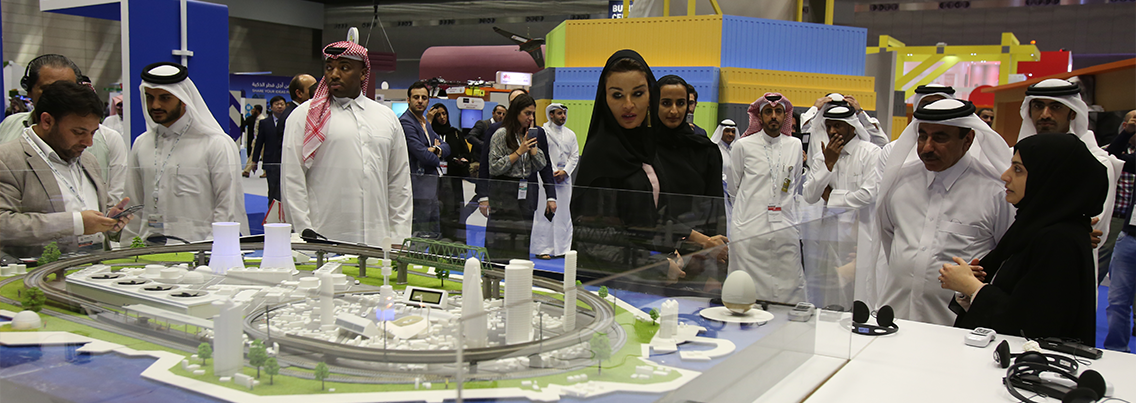 qitcom home page
qitcom home page
Qatar: A Safe Smart Journey
Imagine you have a holiday planned with your family to celebrate your son’s 10th birthday. Today is your last day at work before you get into vacation mode. As last days usually go, endless meetings cause a delay, leaving you with only sixty minutes to catch your Qatar Airways flight. You finally wrap up your work and launch the ‘Karwa’ taxi application on your mobile, hoping it arrives soon for you to make it from West Bay to the airport on time. Your ride arrives within seconds and takes you to Hamad International Airport. The smooth roads and intelligent road signs help the Karwa driver get you to the airport in ten minutes. Your anticipation comes true when you witness a queue at the check-in counter, making you dread the long wait. Thankfully, this will not be the case because Qatar has been working relentlessly over the past few years to provide smart solutions to enhance the quality of life for its citizens, residents and visitors.
Based on the latest United Nations estimates, the current population of Qatar is 2,744,854, of which 91.3% is urban with most people in the age range of 30-40 years. Qatar’s population has grown by 54% in the past decade and is looking to grow at a rapid rate in the coming years as well. To address this urbanization, the Ministry of Transport and Communications (MoTC) decided to steer Qatar in the ‘smart’ direction. With the MoTC team at the driving seat of this mission, Qatar has been investing heavily in digital innovation and disruptive technologies across sectors, to take the country’s National Vision 2030 forward.
Her Excellency Reem Al Mansoori, Assistant Undersecretary of Digital Society Development, Ministry of Transport and Communications said, “Qatar has been at the front lines of a global transformation towards Safe Smart Cities, to become more efficient, more sustainable and more connected. The nation has been pioneering smart living solutions by driving world-class research and innovation, as well as massive investments in smart infrastructure. Smart solutions being implemented across sectors reflect the country’s willingness to build a better future for its current and future generations. From the launch of smart security robots at the airport to 3D printers and Super Computers in hospitals, our nation is emerging as one of the most technologically advanced countries in the world”.
To ease the travel experience for global citizens, Qatar’s National Tourism Council collaborated with the Ministry of Interior and VFS Global in 2017, to automate the visa application process for all passengers. The new system allows passengers traveling to Qatar to use the system irrespective of the airline they travelled by. It was meant to be a robust online platform that provided ease and flexibility to tourists visiting Qatar. Mr. Hassan Al Ibrahim Assistant Secretary General QNTC, said, “Enhancing the visitor experience at every touch-point lies at the core of our tourism development vision, and we believe this begins even as the visitor is planning their trip. That is why implementing smart visa solutions that facilitate entry to Qatar has been a critical component of our efforts over the past several years, and their success has earned Qatar the ranking of most open country in the Middle East and 8th most open in the world. We continue to integrate smart solutions that further enrich the visitor experience, such as special visa application portals that are tied to seasonal festivals.”
In October 2018, Hamad International Airport (HIA) successfully completed the first major phase of its Smart Airport program enabling up to 40% of the home carrier Qatar Airways’ passengers preferring to self-check-in; and a further 20% opting for self-bag-drop. The airport installed 62 next-generation self-check-in and 12 self-bag drop kiosks including future biometric technology capability, enabling passengers to check in, print their boarding passes and bag tags, as well as tag their bags and drop them at the kiosks before proceeding to border control. HIA has also introduced an Automated Visa Document Check, which is the first of its kind in any major Airport worldwide which allows ground services agents to check a passenger’s visa documentation before continuing their journey. Today, passengers are satisfied with the increased autonomy and faster, hassle-free airport experience associated with the completion of the first phase of the Smart Airport program./span>
In October 2018, Hamad International Airport (HIA) successfully completed the first major phase of its Smart Airport program enabling up to 40% of the home carrier Qatar Airways’ passengers preferring to self-check-in; and a further 20% opting for self-bag-drop. The airport installed 62 next-generation self-check-in and 12 self-bag drop kiosks including future biometric technology capability, enabling passengers to check in, print their boarding passes and bag tags, as well as tag their bags and drop them at the kiosks before proceeding to border control. HIA has also introduced an Automated Visa Document Check, which is the first of its kind in any major Airport worldwide which allows ground services agents to check a passenger’s visa documentation before continuing their journey. Today, passengers are satisfied with the increased autonomy and faster, hassle-free airport experience associated with the completion of the first phase of the Smart Airport program./span>
Building on this central piece of the airport’s digital strategy, HIA launched the second phase of its ‘Smart Airport Program’ in August 2019. The systems in this phase of the program are currently under trial. The objective is to combine passengers’ flight, passport, and facial biometric information in a single electronic record at the self-check-in kiosk or mobile app. Furthermore, only the passenger’s face will become the sole requirement for the verification process at the self-service bag-drop, automated security gate, and the automated boarding gate, making the experience fast and seamless. HIA’s Smart Airport program helps empower passengers and provide them with a swift and seamless experience.
As Qatar is becoming one of the world's busiest destinations, HIA has recently launched the next phase of its expansion plan to boost the airport’s passenger handling capacity. This year was a special one for HIA, as they completed five years of operations. During the first and second phases of the Smart Airport Program, Qatar’s five-star airport witnessed increased efficiency and independence for passengers travelling through HIA. The HIA team aims to accommodate 53 million passengers annually by 2022. The expansion will also see the construction of an Airport City which will provide significant future investment opportunities and help HIA anticipate and respond to the needs of tomorrow’s travelers. HIA will continue to unlock the power of technology to empower passengers and optimize operational efficiency as one of the most technologically advanced aviation hubs in the world.
Travelers also save time by accessing the facial biometric system through a mobile application before making their way to the Ministry of Interior’s E-gate system. The electronic gate does not require prior registration for residents and citizens and only requires a Qatar ID to cut across the daunting crowd and wade through the immigration zone. The E-gate system was launched by the Ministry of Interior in 2016, as part of the ‘Smart Passenger Project’ at the airport to help passengers speed through travel procedures. E-gates are available at nineteen departure and sixteen arrival lounges at Hamad International Airport to help passengers avoid long queues. The QID takes less than two minutes to read the vital passenger data stored on the card or the passport and verify them, ensuring their privacy, security and safety. The electronic gate also helps travelers save passport pages, as many of them suffer from rapid depletion of available pages in their passports due to the large number of travel stamps.
Colonel Mohamed Rashid al-Mazroui, Director of the Airport Passports Department at the Ministry of Interior, commented, “The activation of the electronic gates for residents has been contributing to the quick completion of travel procedures. Our aim was to help passengers avoid endless queues and passport control officers to verify their personal data and put the departure or arrival stamp on their passports, and we are proud to say that we accomplished our vision with success.” In author Arthur C. Clarke’s words, “Any sufficiently advanced technology is equivalent to magic” and magic it has been. A year ago, one would have given up the hope of catching a flight that was scheduled to take off in the next sixty minutes. Today, it is a reality that the residents, citizens and visitors of Qatar experience.
The reason for elaborating the above situation was to underline the increasing presence of efficient technologies brought together through a seamless integration between relevant parties that are driving the Smart Qatar vision. Some of the fitting examples of the strides Qatar has been taking in the field of technology, include the virtual and augmented reality classrooms that educate students in an inspiring way to discover eons of history, the remote patient health monitoring systems that have revolutionized the patient experience, the agricultural boom with dairy farms and smart farming solutions, Lusail and Msheireb smart cities, and smart tracking devices that ensure the safety of Qatar’s furry friends. The future is promising for Qatar, and it is believed that by 2030, the country will achieve their goals towards developing the economic, social, environmental and human pillars.
Like the transport sector, various other sectors have been driving smart projects in the country. Bringing all these technologies together this year will be the Qatar International Conference & Exhibition, organized by the Ministry of Transport and Communications. This year’s theme, ‘Safe Smart Cities’ will demonstrate how sustainable, digitized environments will contribute to enhanced experiences for current and future generations. It will feature an exclusive zone showcasing the Ministry of Transportation and Communication and its flagship smart living initiative – TASMU, an ICT ecosystem bringing smart solutions to life for the citizens, residents and visitors in Qatar. Tasmu aims to enhance the delivery of public services in Qatar across five priority sectors: transport, logistics, environment, health care and sports. Created as a digital response to Qatar’s National Vision 2030, TASMU is a platform that thrives on collaboration and co-creation and helps bring together several local entities to work together to deliver the national goals. TASMU along with other digital enterprises aims to generate around QR 40 billion for the national economy over the next five years, while also creating a robust job market in the ICT sector.
Qatar IT Conference & Exhibition 2019 is a catalyst for the development of safe smart city solutions in Qatar and around the globe. It aims to bring together consumers and global experts enabling them to understand, envision and build a safe and better digital future. Positioning Qatar as a regional leader in creating a Smart City ecosystem through an integrated approach, the event will contribute to creating connections across the Smart Cities ecosystem at a national, regional and global level. With over 90 speakers, 300 technology exhibitors, 100 startups and 300 innovators invited, the Qatar IT Exhibition & Conference aims to be a one-stop-shop for participants to showcase disruptive smart technologies and exchange next-generation knowledge.




